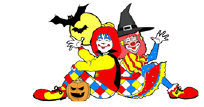 Fire eating is not a trick and can be very dangerous.
Fire eating is not a trick and can be very dangerous.
For obvious reasons I have debated on writing this article for Clown Antics as any act with fire, including fire magic, can lead to injury or worse. However, educating people is what we like to do and this art form is very popular and enticing. So rather than avoid the topic, let’s learn about fire manipulation and what is involved in this level of performance art. I am by no means encouraging anyone to try this or take up the art but wish to enlighten people as to what is involved and of course the possible dangers.
A little history:
The art of fire manipulation is a rather ancient practice; part of Hindu, Sadhu and Fakir performances to show spiritual enlightenment. The late 1880’s this became a common site in sideshows later moving to the main circus ring with more advanced moves like retaining a lit flame in the performers mouth then lighting other objects on fire. Fire breathing also was added and is quite a thrill for the audience.
Fire breathing and eating:
While both techniques may seem the same to the audience, there are specific differences in the fuels, handling and mind set when executing fire breathing vs. fire eating.
Eating fire uses a low flash point fuel like white camping fuel. This allows for longer burning flames and effects like slow burns (contact with fire and flesh) or vapor pulls (holding the flame in your mouth). Fire eating to simplify is the act of placing a lit torch in ones mouth, do not inhale, and eventually extinguish the flame by cutting off the oxygen to the flame. This is accomplished when the performer closes their mouth around the flame and can be aided by exhaling. The performers mind set is to not inhale the flame and be cautious of wind that can blow the flame on the face or body causing burns. Also one must be aware of flammable surfaces and spectators that could be in harms way.
Fire breathing fuel has a higher flash point so the effect of a fire blast is more dramatic and the flame burns quickly and then self extinguishes. Commonly used fuels are kerosene or paraffin lamp oil. To breathe fire, the performer must take the fuel into their mouth and then spit/spray it out at a lit flame or torch creating the fire blast. This can be very risky as ingesting the fuel most certainly is harmful or even fatal. In addition to not swallowing the fuel, the breather must also consider the wind as to not get burned, set a nearby object on fire or injure any spectators.
Does it hurt?
Yes, yes it does. There is no “trick” to fire manipulation of any style, we are really at risk of injury or death. Although I only eat fire, colleagues of mine that breathe fire do agree with this philosophy. “Fire produces heat, heat is hot, hot things burn, end of story.” That being said, done properly serious burns can be avoided and the fire in the mouth often feels no worse than a hot beverage. If you so start to feel a burn, use the fire cloth to smother the flame.
Do’s:
*Use extreme caution anytime you work with fire.
*Have fire safety measures in place. Wet towel or fire cloth, fire extinguisher or bucket of water is good also.
*Have a spotter to put you out if anything goes bad or to watch for dangerous situations.
*Wear fire resistant clothing, cotton is a good choice.
*Do be aware of your surroundings at all times
Don’ts:
*Do not take chances by skipping safety measures.
*Do not perform if the conditions could present safety issues to you or others.
*Do not let others “play” with your equipment, they are tools, not toys.
Who should try fire stunts?
No one should ever attempt fire eating, breathing or manipulation, it is dangerous and the fuel is very harmful to the performer.
Who does try fire eating or breathing?
Many people experiment and if not cautious or properly trained, many get hurt or even have died from fire inhalation or poised from the fuel.
Who is successful at fire manipulation?
Those who have seriously read and studied the art, carefully weighed the possible dangers, respect the flame and have sought competent training may be successful in the fire arts. This does not mean that accidents can not happen. Even with using every safety measure and extreme caution, one can still get burned or ingest fuels that could be fatal.





